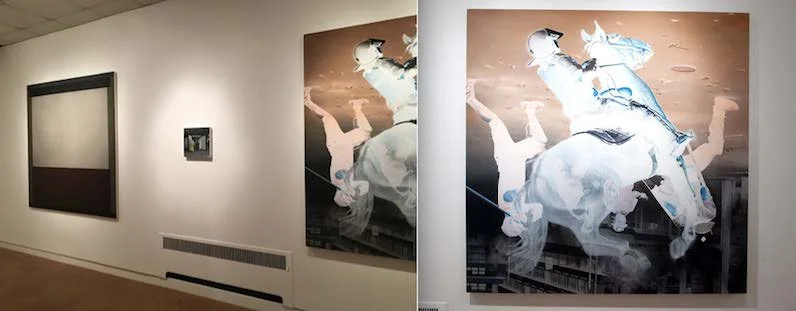Where is Nuance Found? A Review of Arterial Echoes:Three Generations of Creative Mentoring
Arterial Echoes: Three Generations of Creative Mentoring, at UMKC’s Gallery of Art , which
ran from September 8th through October 28th 2016, presented a series of work shown in
eight groups of three: one UMKC faculty member, their mentor, and a student (the faculty
member taught). With a diverse representation of drawing, painting, print, and digital media,
cohesiveness was achieved through presenting these triad relationships.
The carefully crafted title, Arterial Echoes, was meant to showcase parallels in the highly
diverse works. That diversity as a whole lessened the specific emphasis on these shared
connections. Our ability to trace the routes these artists followed to conjure their own work
stopped short when we only got to see one piece from each artist in a grouping.
Installation image of Arterial Echoes image courtesy of UMKC Gallery
For instance, with the work of Ricky Allman, we saw only a single painting from his larger
body of work, and only one work plucked from his mentor’s and student’s portfolio. This
relationship is narrow. The problem is that the works chosen were too distilled; they did not
seem to be carefully decided and consequently destroy the contextual oeuvre of each artist.
They focused more on comparing directly to the professors than to the mentors and students
as artists with broad practices themselves. The show would have been stronger if it focused
on more work from one or two triads of artists and allowed conversations to occur within the
gallery. There is simply not enough to compare, and ironically, too much.
Works by Timothy App, Andy McIlvaine, Davin Watne. Images by the author (left) and courtesy of the
UMKC Gallery (right)
This show did not showcase all three artists’ works made concurrently, which could have
better represented practices in adjacency to each other. The years in which the work were
pulled appear random and unconsidered. Within one triad of works, professor Kati
Toivanen’s has work from 2015, mentor Stephen DiRado’s was from 1987, and the student
Sarah Kraly’s was from 2009. Contrarily, in another triad, professor Ricky Allman’s work was
from 2015, mentor Hyunmee Lee’s from 2015, and student Sopearb Touch’s from 2016.
Logically, with narrowed time gaps between more current works, routes are more accessible
and cohesive. This particular grouping of Allman, Lee, and Touch was one of the strongest
in the show in terms of how it highlighted the formal kinship between the artists.
With an intent to emphasize a route where the artists gave themselves permission to use the
tools their predecessor provided, connections became apparent formally, moving from
surface to surface of each piece in the show. The oil paintings of UMKC professor Davin
Watne, his mentor Timothy App, and Watne’s student Andrew McIlvaine did strongly
represent this route. What becomes evident in this grouping is that we often overlook the
impact of our influences. The similarity of the monochromatic color palettes were obvious.
After recognition of what else exists within the frame of view, the rest of the linking elements
became clear. While content is broad in this group, compositionally, the paintings were very
similar through the treatment of the frame. The atmosphere, dull and thick, surrounded the
illuminated centers of each work.
But these were three works out of
twenty-one. The other eighteen were
not necessarily linkable to these three.
If they were — it is a stretch. There are
photo prints, etchings, and video work;
all of which don’t necessarily talk to any
of the other groupings. This show is full
of separate micro conversations,
without a focus on the whole. Unlike a
museum, that sections off works in
expansive rooms by time period
showing a large breadth of a particular
movement, this show was doing too
much with too little space. If this had
been eight mini shows with more work,
and more room it could have been
more exciting — and also more
specific. The goal of the exhibition, to
exhibit three generations of mentoring,
lost its luster when too many
connections were trying to be made
This exhibition found success in how
these relationships echo one another
formally. We expand our ideas through
being influenced by those around us. This particular exhibition complicated this intent with its
broadness. There were many disparate pieces that made the show like a garment unraveling
a broad history. One could find the thread between the work of Stephen DiRado from one
triad, of Elija Gowin from another, Andrew McIlvaine from another, and so on. These
possibilities made it apparent that there were an infinite amount of threads to be traced
without the support of a solid thesis beyond formal comparisons.



